University Quality Assurance and Control Assignment - Module 7-9
VerifiedAdded on 2020/10/23
|31
|10412
|76
Homework Assignment
AI Summary
This document presents a comprehensive solution to a Quality Assurance and Control assignment, encompassing modules 7-9. It delves into various aspects of quality management, including total quality management (TQM), its objectives, and benefits. The solution explores the steps of PDCA, hazard analysis, and critical control points (HACCP), along with ICH objectives and FMEA applications. It further addresses quality risk management for facilities and equipment, corrective and preventive actions (CAPA), and activities for continuous improvement of pharmaceutical quality systems. The assignment also covers quality system models, handling nonconformities, and ISO standards related to risk management. Additionally, it examines inspection objectives, roles of inspectors, site master files, drug classifications, and sterilization methods. Furthermore, the document provides insights into the roles of supervisory authorities, site inspection objectives, deficiencies, and the language of audit reports. The solution also discusses various aspects of documentation, including drug master files, standard operating procedures (SOPs), batch manufacturing records, and the common technical document (CTD), as per US FDA and other regulatory bodies. The content is a thorough guide to the subject, offering valuable insights into the pharmaceutical quality assurance domain.
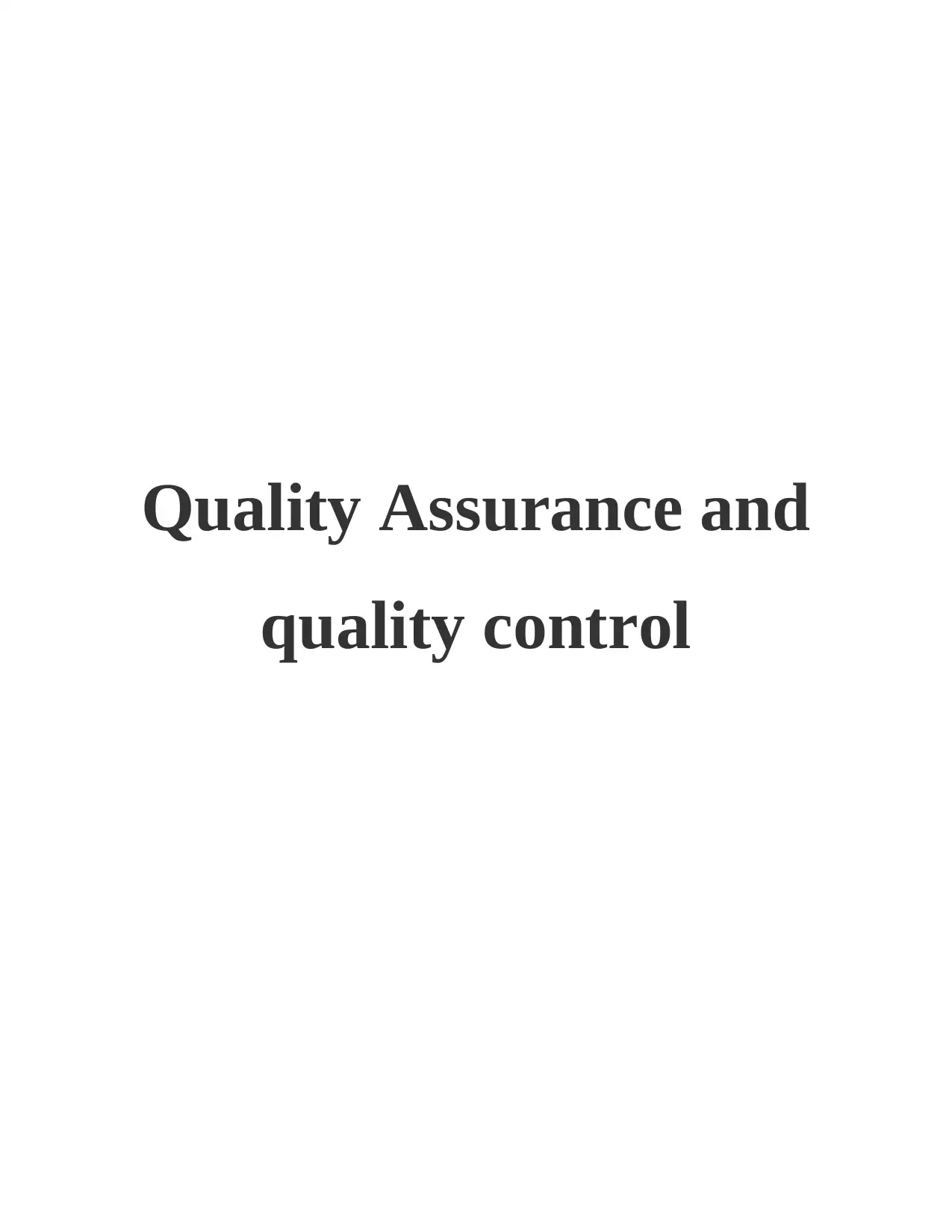
Quality Assurance and
quality control
quality control
Paraphrase This Document
Need a fresh take? Get an instant paraphrase of this document with our AI Paraphraser
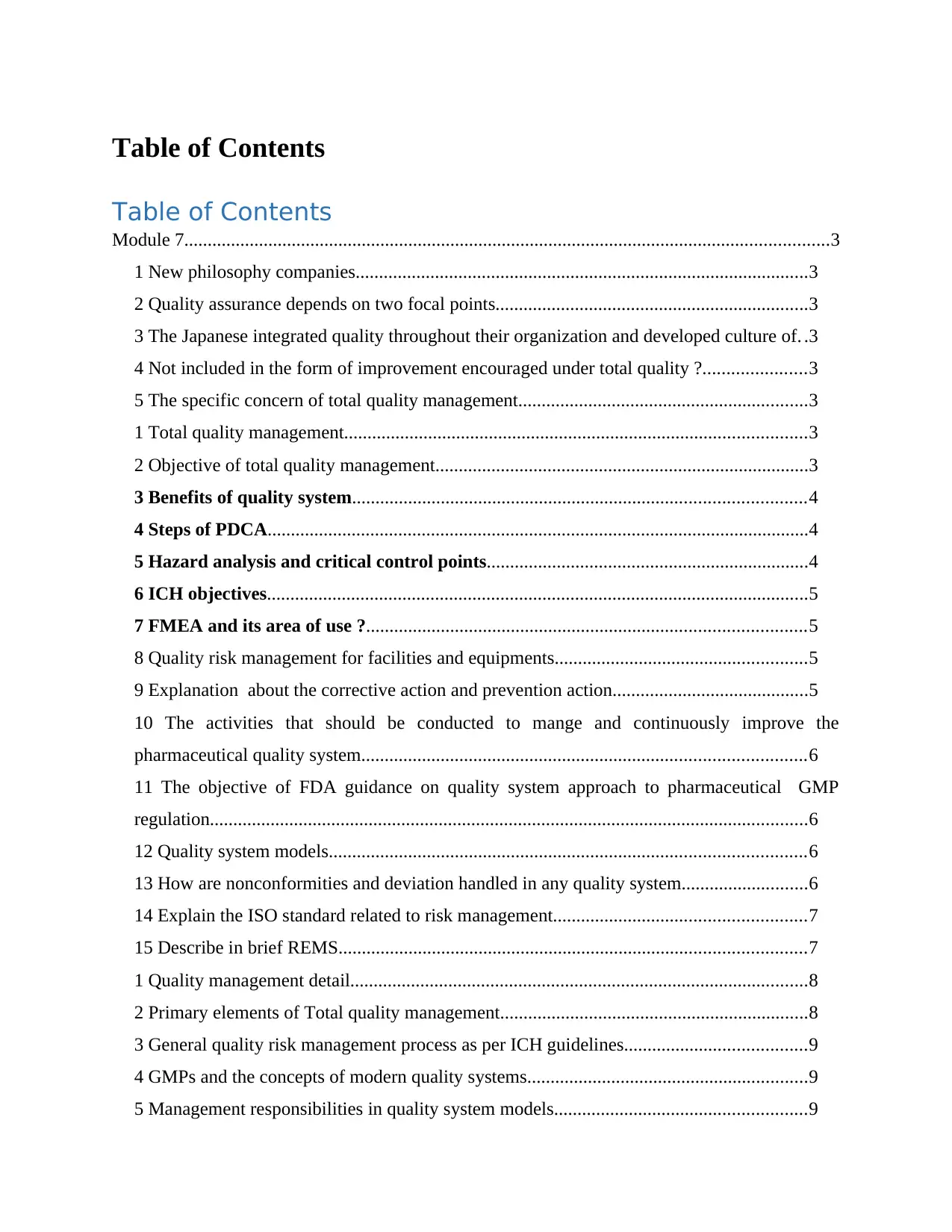
Table of Contents
Table of Contents
Module 7..........................................................................................................................................3
1 New philosophy companies.................................................................................................3
2 Quality assurance depends on two focal points...................................................................3
3 The Japanese integrated quality throughout their organization and developed culture of. .3
4 Not included in the form of improvement encouraged under total quality ?......................3
5 The specific concern of total quality management..............................................................3
1 Total quality management...................................................................................................3
2 Objective of total quality management................................................................................3
3 Benefits of quality system.................................................................................................4
4 Steps of PDCA....................................................................................................................4
5 Hazard analysis and critical control points.....................................................................4
6 ICH objectives....................................................................................................................5
7 FMEA and its area of use ?..............................................................................................5
8 Quality risk management for facilities and equipments......................................................5
9 Explanation about the corrective action and prevention action..........................................5
10 The activities that should be conducted to mange and continuously improve the
pharmaceutical quality system...............................................................................................6
11 The objective of FDA guidance on quality system approach to pharmaceutical GMP
regulation................................................................................................................................6
12 Quality system models......................................................................................................6
13 How are nonconformities and deviation handled in any quality system...........................6
14 Explain the ISO standard related to risk management......................................................7
15 Describe in brief REMS....................................................................................................7
1 Quality management detail..................................................................................................8
2 Primary elements of Total quality management..................................................................8
3 General quality risk management process as per ICH guidelines.......................................9
4 GMPs and the concepts of modern quality systems............................................................9
5 Management responsibilities in quality system models......................................................9
Table of Contents
Module 7..........................................................................................................................................3
1 New philosophy companies.................................................................................................3
2 Quality assurance depends on two focal points...................................................................3
3 The Japanese integrated quality throughout their organization and developed culture of. .3
4 Not included in the form of improvement encouraged under total quality ?......................3
5 The specific concern of total quality management..............................................................3
1 Total quality management...................................................................................................3
2 Objective of total quality management................................................................................3
3 Benefits of quality system.................................................................................................4
4 Steps of PDCA....................................................................................................................4
5 Hazard analysis and critical control points.....................................................................4
6 ICH objectives....................................................................................................................5
7 FMEA and its area of use ?..............................................................................................5
8 Quality risk management for facilities and equipments......................................................5
9 Explanation about the corrective action and prevention action..........................................5
10 The activities that should be conducted to mange and continuously improve the
pharmaceutical quality system...............................................................................................6
11 The objective of FDA guidance on quality system approach to pharmaceutical GMP
regulation................................................................................................................................6
12 Quality system models......................................................................................................6
13 How are nonconformities and deviation handled in any quality system...........................6
14 Explain the ISO standard related to risk management......................................................7
15 Describe in brief REMS....................................................................................................7
1 Quality management detail..................................................................................................8
2 Primary elements of Total quality management..................................................................8
3 General quality risk management process as per ICH guidelines.......................................9
4 GMPs and the concepts of modern quality systems............................................................9
5 Management responsibilities in quality system models......................................................9
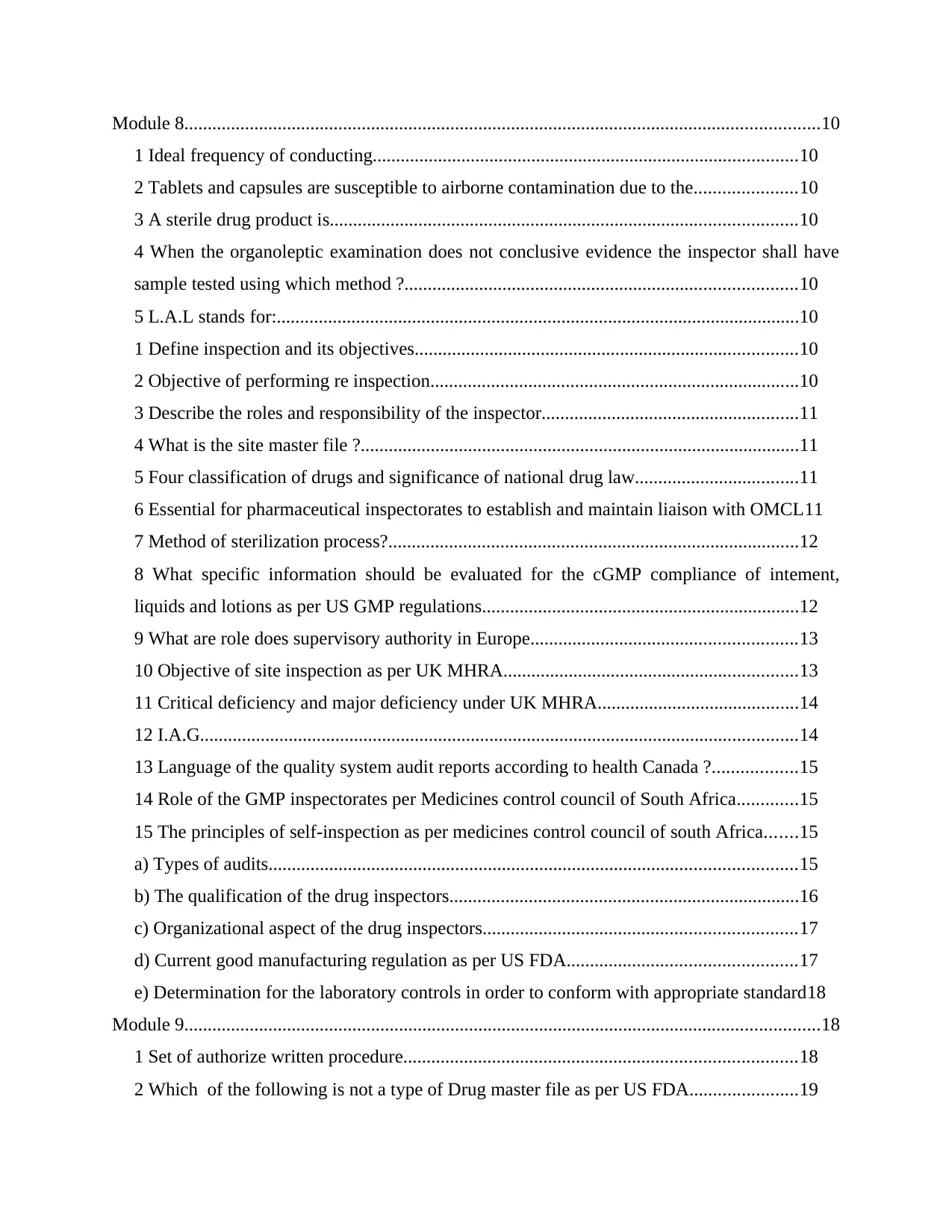
Module 8........................................................................................................................................10
1 Ideal frequency of conducting...........................................................................................10
2 Tablets and capsules are susceptible to airborne contamination due to the......................10
3 A sterile drug product is....................................................................................................10
4 When the organoleptic examination does not conclusive evidence the inspector shall have
sample tested using which method ?....................................................................................10
5 L.A.L stands for:................................................................................................................10
1 Define inspection and its objectives..................................................................................10
2 Objective of performing re inspection...............................................................................10
3 Describe the roles and responsibility of the inspector.......................................................11
4 What is the site master file ?..............................................................................................11
5 Four classification of drugs and significance of national drug law...................................11
6 Essential for pharmaceutical inspectorates to establish and maintain liaison with OMCL11
7 Method of sterilization process?........................................................................................12
8 What specific information should be evaluated for the cGMP compliance of intement,
liquids and lotions as per US GMP regulations....................................................................12
9 What are role does supervisory authority in Europe.........................................................13
10 Objective of site inspection as per UK MHRA...............................................................13
11 Critical deficiency and major deficiency under UK MHRA...........................................14
12 I.A.G................................................................................................................................14
13 Language of the quality system audit reports according to health Canada ?..................15
14 Role of the GMP inspectorates per Medicines control council of South Africa.............15
15 The principles of self-inspection as per medicines control council of south Africa.......15
a) Types of audits.................................................................................................................15
b) The qualification of the drug inspectors...........................................................................16
c) Organizational aspect of the drug inspectors...................................................................17
d) Current good manufacturing regulation as per US FDA.................................................17
e) Determination for the laboratory controls in order to conform with appropriate standard18
Module 9........................................................................................................................................18
1 Set of authorize written procedure....................................................................................18
2 Which of the following is not a type of Drug master file as per US FDA.......................19
1 Ideal frequency of conducting...........................................................................................10
2 Tablets and capsules are susceptible to airborne contamination due to the......................10
3 A sterile drug product is....................................................................................................10
4 When the organoleptic examination does not conclusive evidence the inspector shall have
sample tested using which method ?....................................................................................10
5 L.A.L stands for:................................................................................................................10
1 Define inspection and its objectives..................................................................................10
2 Objective of performing re inspection...............................................................................10
3 Describe the roles and responsibility of the inspector.......................................................11
4 What is the site master file ?..............................................................................................11
5 Four classification of drugs and significance of national drug law...................................11
6 Essential for pharmaceutical inspectorates to establish and maintain liaison with OMCL11
7 Method of sterilization process?........................................................................................12
8 What specific information should be evaluated for the cGMP compliance of intement,
liquids and lotions as per US GMP regulations....................................................................12
9 What are role does supervisory authority in Europe.........................................................13
10 Objective of site inspection as per UK MHRA...............................................................13
11 Critical deficiency and major deficiency under UK MHRA...........................................14
12 I.A.G................................................................................................................................14
13 Language of the quality system audit reports according to health Canada ?..................15
14 Role of the GMP inspectorates per Medicines control council of South Africa.............15
15 The principles of self-inspection as per medicines control council of south Africa.......15
a) Types of audits.................................................................................................................15
b) The qualification of the drug inspectors...........................................................................16
c) Organizational aspect of the drug inspectors...................................................................17
d) Current good manufacturing regulation as per US FDA.................................................17
e) Determination for the laboratory controls in order to conform with appropriate standard18
Module 9........................................................................................................................................18
1 Set of authorize written procedure....................................................................................18
2 Which of the following is not a type of Drug master file as per US FDA.......................19
⊘ This is a preview!⊘
Do you want full access?
Subscribe today to unlock all pages.

Trusted by 1+ million students worldwide
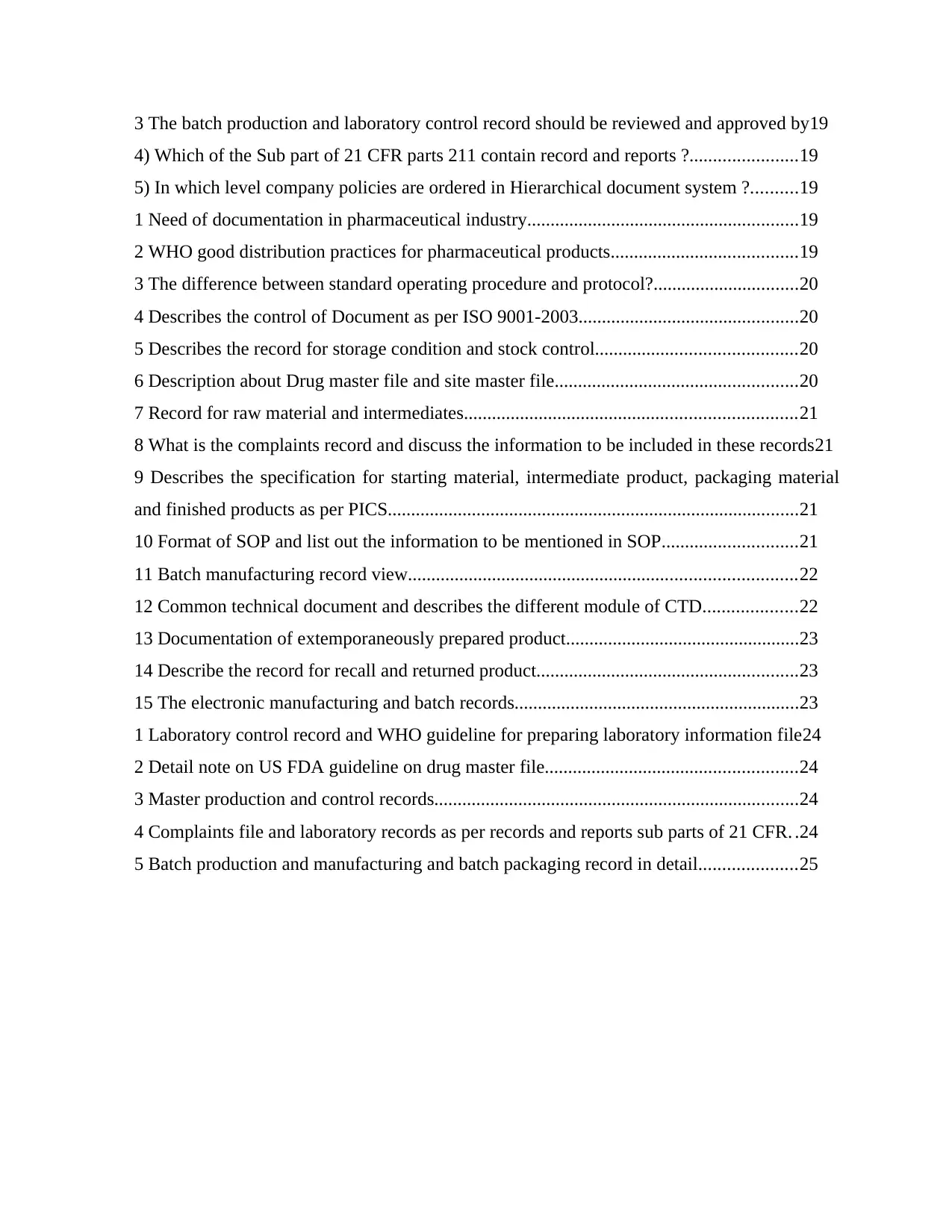
3 The batch production and laboratory control record should be reviewed and approved by19
4) Which of the Sub part of 21 CFR parts 211 contain record and reports ?.......................19
5) In which level company policies are ordered in Hierarchical document system ?..........19
1 Need of documentation in pharmaceutical industry..........................................................19
2 WHO good distribution practices for pharmaceutical products........................................19
3 The difference between standard operating procedure and protocol?...............................20
4 Describes the control of Document as per ISO 9001-2003...............................................20
5 Describes the record for storage condition and stock control...........................................20
6 Description about Drug master file and site master file....................................................20
7 Record for raw material and intermediates.......................................................................21
8 What is the complaints record and discuss the information to be included in these records21
9 Describes the specification for starting material, intermediate product, packaging material
and finished products as per PICS........................................................................................21
10 Format of SOP and list out the information to be mentioned in SOP.............................21
11 Batch manufacturing record view...................................................................................22
12 Common technical document and describes the different module of CTD....................22
13 Documentation of extemporaneously prepared product..................................................23
14 Describe the record for recall and returned product........................................................23
15 The electronic manufacturing and batch records.............................................................23
1 Laboratory control record and WHO guideline for preparing laboratory information file24
2 Detail note on US FDA guideline on drug master file......................................................24
3 Master production and control records..............................................................................24
4 Complaints file and laboratory records as per records and reports sub parts of 21 CFR. .24
5 Batch production and manufacturing and batch packaging record in detail.....................25
4) Which of the Sub part of 21 CFR parts 211 contain record and reports ?.......................19
5) In which level company policies are ordered in Hierarchical document system ?..........19
1 Need of documentation in pharmaceutical industry..........................................................19
2 WHO good distribution practices for pharmaceutical products........................................19
3 The difference between standard operating procedure and protocol?...............................20
4 Describes the control of Document as per ISO 9001-2003...............................................20
5 Describes the record for storage condition and stock control...........................................20
6 Description about Drug master file and site master file....................................................20
7 Record for raw material and intermediates.......................................................................21
8 What is the complaints record and discuss the information to be included in these records21
9 Describes the specification for starting material, intermediate product, packaging material
and finished products as per PICS........................................................................................21
10 Format of SOP and list out the information to be mentioned in SOP.............................21
11 Batch manufacturing record view...................................................................................22
12 Common technical document and describes the different module of CTD....................22
13 Documentation of extemporaneously prepared product..................................................23
14 Describe the record for recall and returned product........................................................23
15 The electronic manufacturing and batch records.............................................................23
1 Laboratory control record and WHO guideline for preparing laboratory information file24
2 Detail note on US FDA guideline on drug master file......................................................24
3 Master production and control records..............................................................................24
4 Complaints file and laboratory records as per records and reports sub parts of 21 CFR. .24
5 Batch production and manufacturing and batch packaging record in detail.....................25
Paraphrase This Document
Need a fresh take? Get an instant paraphrase of this document with our AI Paraphraser
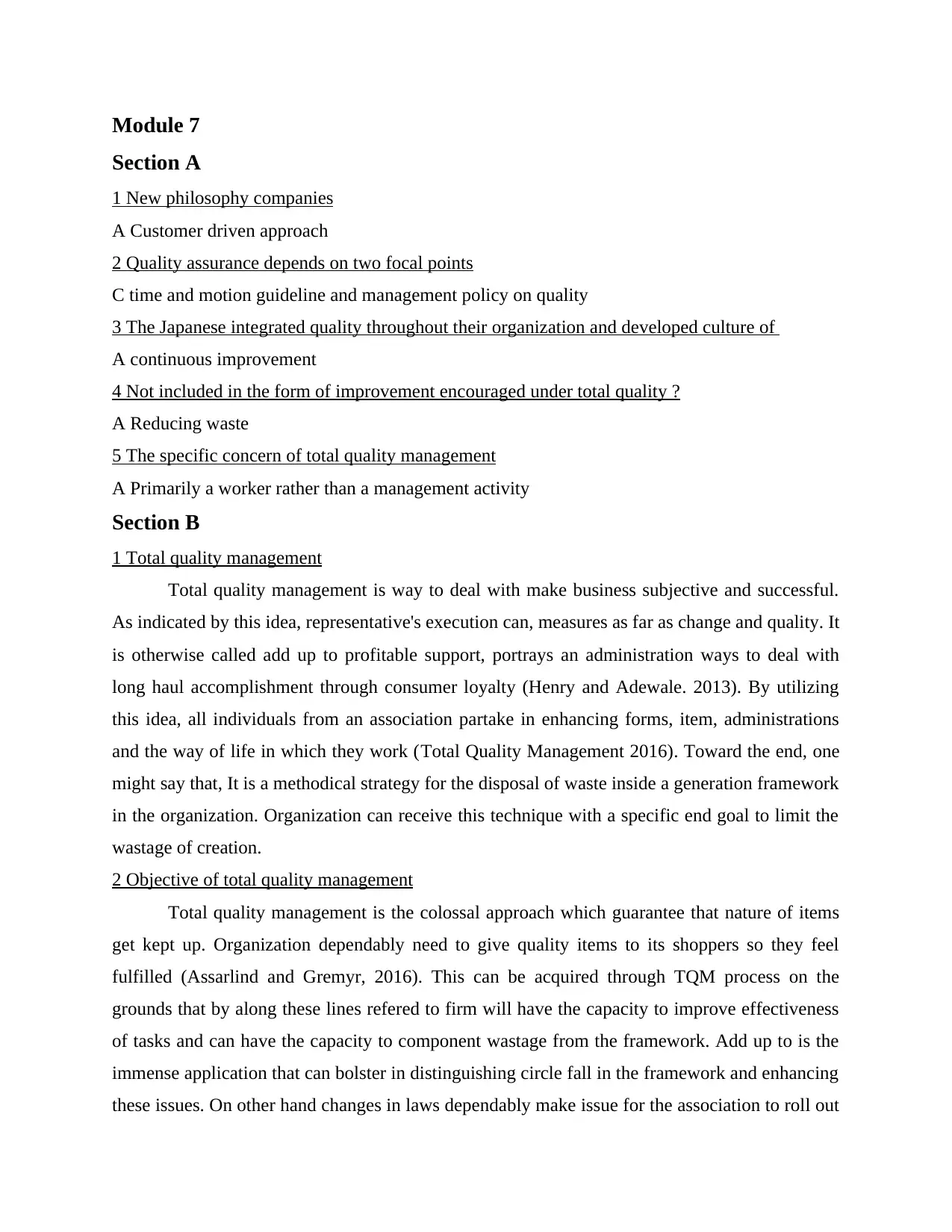
Module 7
Section A
1 New philosophy companies
A Customer driven approach
2 Quality assurance depends on two focal points
C time and motion guideline and management policy on quality
3 The Japanese integrated quality throughout their organization and developed culture of
A continuous improvement
4 Not included in the form of improvement encouraged under total quality ?
A Reducing waste
5 The specific concern of total quality management
A Primarily a worker rather than a management activity
Section B
1 Total quality management
Total quality management is way to deal with make business subjective and successful.
As indicated by this idea, representative's execution can, measures as far as change and quality. It
is otherwise called add up to profitable support, portrays an administration ways to deal with
long haul accomplishment through consumer loyalty (Henry and Adewale. 2013). By utilizing
this idea, all individuals from an association partake in enhancing forms, item, administrations
and the way of life in which they work (Total Quality Management 2016). Toward the end, one
might say that, It is a methodical strategy for the disposal of waste inside a generation framework
in the organization. Organization can receive this technique with a specific end goal to limit the
wastage of creation.
2 Objective of total quality management
Total quality management is the colossal approach which guarantee that nature of items
get kept up. Organization dependably need to give quality items to its shoppers so they feel
fulfilled (Assarlind and Gremyr, 2016). This can be acquired through TQM process on the
grounds that by along these lines refered to firm will have the capacity to improve effectiveness
of tasks and can have the capacity to component wastage from the framework. Add up to is the
immense application that can bolster in distinguishing circle fall in the framework and enhancing
these issues. On other hand changes in laws dependably make issue for the association to roll out
Section A
1 New philosophy companies
A Customer driven approach
2 Quality assurance depends on two focal points
C time and motion guideline and management policy on quality
3 The Japanese integrated quality throughout their organization and developed culture of
A continuous improvement
4 Not included in the form of improvement encouraged under total quality ?
A Reducing waste
5 The specific concern of total quality management
A Primarily a worker rather than a management activity
Section B
1 Total quality management
Total quality management is way to deal with make business subjective and successful.
As indicated by this idea, representative's execution can, measures as far as change and quality. It
is otherwise called add up to profitable support, portrays an administration ways to deal with
long haul accomplishment through consumer loyalty (Henry and Adewale. 2013). By utilizing
this idea, all individuals from an association partake in enhancing forms, item, administrations
and the way of life in which they work (Total Quality Management 2016). Toward the end, one
might say that, It is a methodical strategy for the disposal of waste inside a generation framework
in the organization. Organization can receive this technique with a specific end goal to limit the
wastage of creation.
2 Objective of total quality management
Total quality management is the colossal approach which guarantee that nature of items
get kept up. Organization dependably need to give quality items to its shoppers so they feel
fulfilled (Assarlind and Gremyr, 2016). This can be acquired through TQM process on the
grounds that by along these lines refered to firm will have the capacity to improve effectiveness
of tasks and can have the capacity to component wastage from the framework. Add up to is the
immense application that can bolster in distinguishing circle fall in the framework and enhancing
these issues. On other hand changes in laws dependably make issue for the association to roll out
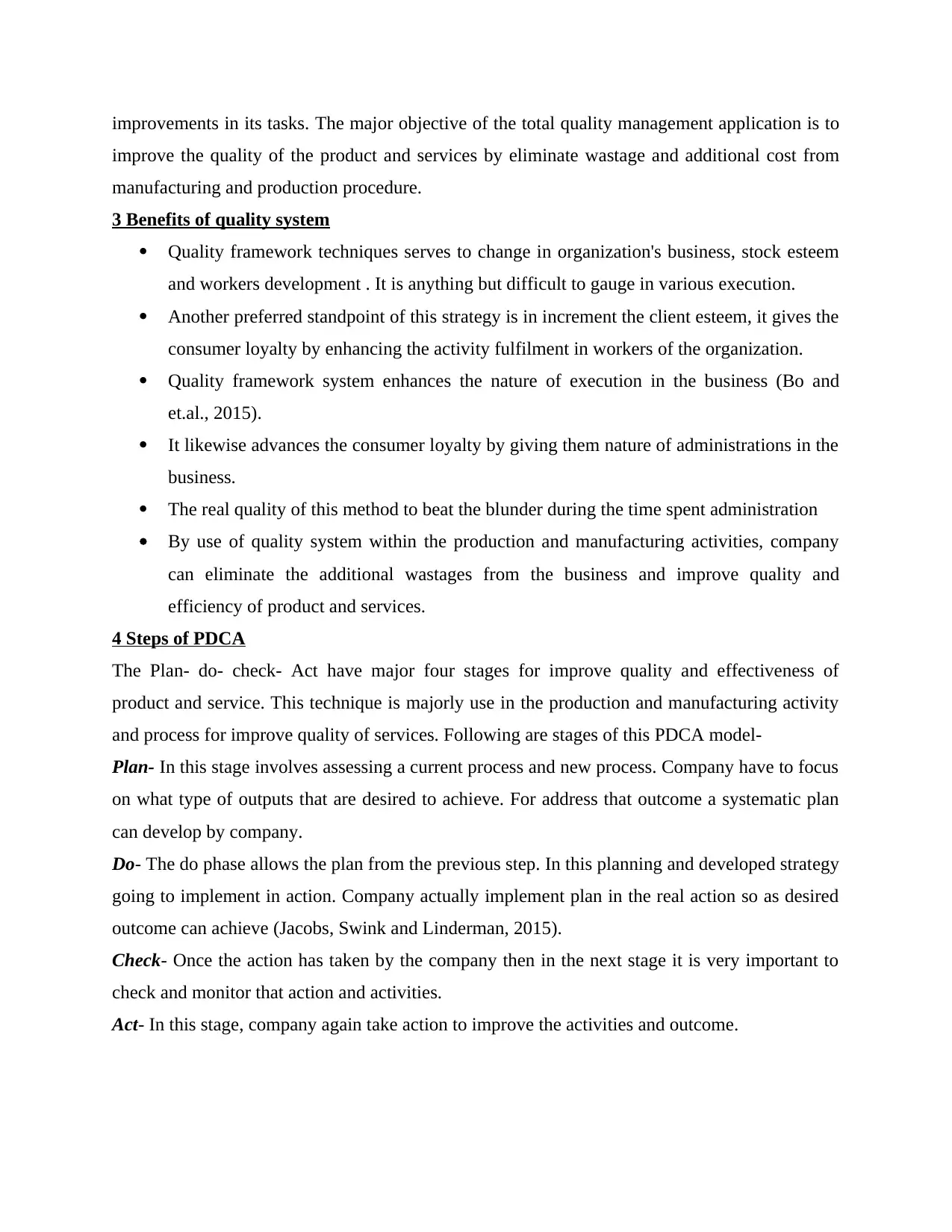
improvements in its tasks. The major objective of the total quality management application is to
improve the quality of the product and services by eliminate wastage and additional cost from
manufacturing and production procedure.
3 Benefits of quality system
Quality framework techniques serves to change in organization's business, stock esteem
and workers development . It is anything but difficult to gauge in various execution.
Another preferred standpoint of this strategy is in increment the client esteem, it gives the
consumer loyalty by enhancing the activity fulfilment in workers of the organization.
Quality framework system enhances the nature of execution in the business (Bo and
et.al., 2015).
It likewise advances the consumer loyalty by giving them nature of administrations in the
business.
The real quality of this method to beat the blunder during the time spent administration
By use of quality system within the production and manufacturing activities, company
can eliminate the additional wastages from the business and improve quality and
efficiency of product and services.
4 Steps of PDCA
The Plan- do- check- Act have major four stages for improve quality and effectiveness of
product and service. This technique is majorly use in the production and manufacturing activity
and process for improve quality of services. Following are stages of this PDCA model-
Plan- In this stage involves assessing a current process and new process. Company have to focus
on what type of outputs that are desired to achieve. For address that outcome a systematic plan
can develop by company.
Do- The do phase allows the plan from the previous step. In this planning and developed strategy
going to implement in action. Company actually implement plan in the real action so as desired
outcome can achieve (Jacobs, Swink and Linderman, 2015).
Check- Once the action has taken by the company then in the next stage it is very important to
check and monitor that action and activities.
Act- In this stage, company again take action to improve the activities and outcome.
improve the quality of the product and services by eliminate wastage and additional cost from
manufacturing and production procedure.
3 Benefits of quality system
Quality framework techniques serves to change in organization's business, stock esteem
and workers development . It is anything but difficult to gauge in various execution.
Another preferred standpoint of this strategy is in increment the client esteem, it gives the
consumer loyalty by enhancing the activity fulfilment in workers of the organization.
Quality framework system enhances the nature of execution in the business (Bo and
et.al., 2015).
It likewise advances the consumer loyalty by giving them nature of administrations in the
business.
The real quality of this method to beat the blunder during the time spent administration
By use of quality system within the production and manufacturing activities, company
can eliminate the additional wastages from the business and improve quality and
efficiency of product and services.
4 Steps of PDCA
The Plan- do- check- Act have major four stages for improve quality and effectiveness of
product and service. This technique is majorly use in the production and manufacturing activity
and process for improve quality of services. Following are stages of this PDCA model-
Plan- In this stage involves assessing a current process and new process. Company have to focus
on what type of outputs that are desired to achieve. For address that outcome a systematic plan
can develop by company.
Do- The do phase allows the plan from the previous step. In this planning and developed strategy
going to implement in action. Company actually implement plan in the real action so as desired
outcome can achieve (Jacobs, Swink and Linderman, 2015).
Check- Once the action has taken by the company then in the next stage it is very important to
check and monitor that action and activities.
Act- In this stage, company again take action to improve the activities and outcome.
⊘ This is a preview!⊘
Do you want full access?
Subscribe today to unlock all pages.

Trusted by 1+ million students worldwide
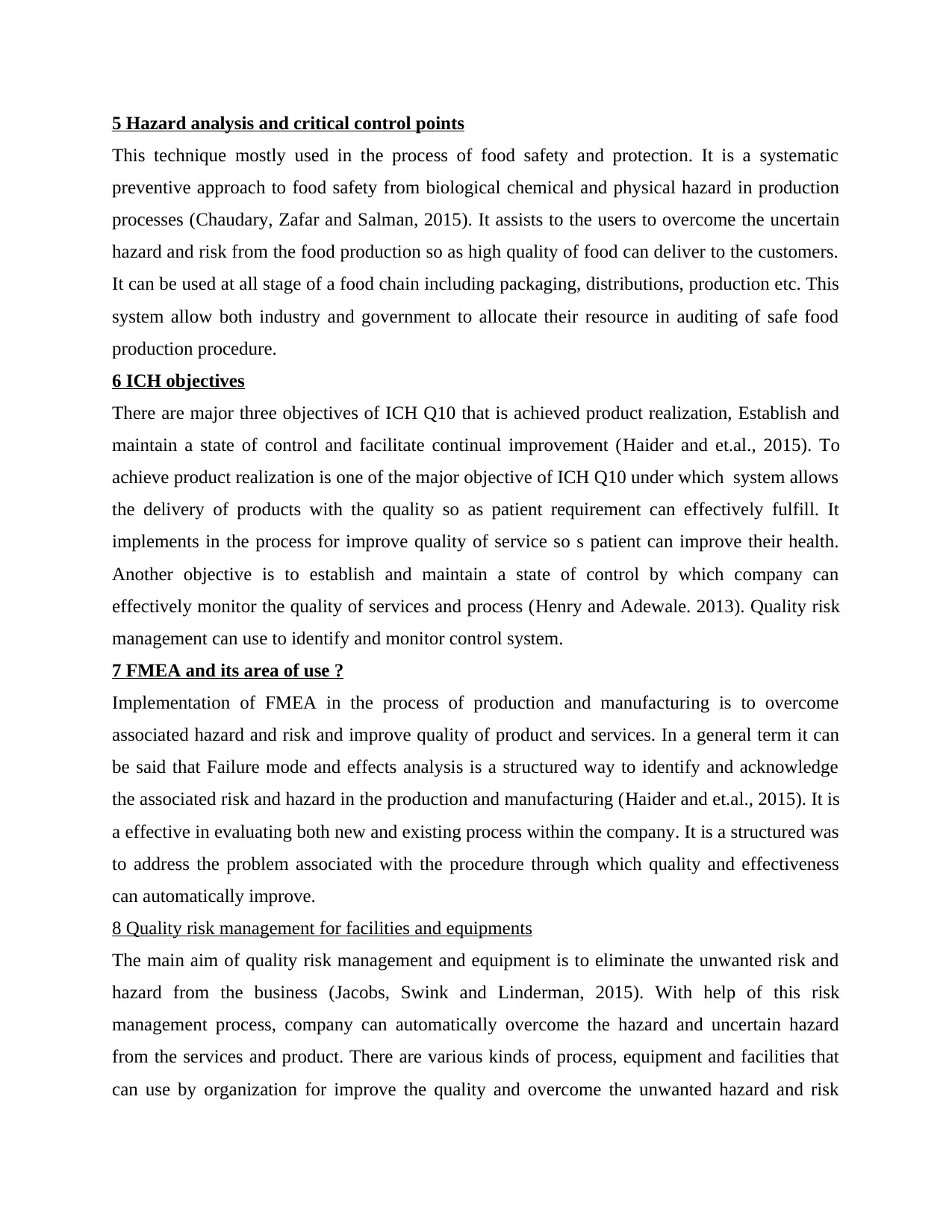
5 Hazard analysis and critical control points
This technique mostly used in the process of food safety and protection. It is a systematic
preventive approach to food safety from biological chemical and physical hazard in production
processes (Chaudary, Zafar and Salman, 2015). It assists to the users to overcome the uncertain
hazard and risk from the food production so as high quality of food can deliver to the customers.
It can be used at all stage of a food chain including packaging, distributions, production etc. This
system allow both industry and government to allocate their resource in auditing of safe food
production procedure.
6 ICH objectives
There are major three objectives of ICH Q10 that is achieved product realization, Establish and
maintain a state of control and facilitate continual improvement (Haider and et.al., 2015). To
achieve product realization is one of the major objective of ICH Q10 under which system allows
the delivery of products with the quality so as patient requirement can effectively fulfill. It
implements in the process for improve quality of service so s patient can improve their health.
Another objective is to establish and maintain a state of control by which company can
effectively monitor the quality of services and process (Henry and Adewale. 2013). Quality risk
management can use to identify and monitor control system.
7 FMEA and its area of use ?
Implementation of FMEA in the process of production and manufacturing is to overcome
associated hazard and risk and improve quality of product and services. In a general term it can
be said that Failure mode and effects analysis is a structured way to identify and acknowledge
the associated risk and hazard in the production and manufacturing (Haider and et.al., 2015). It is
a effective in evaluating both new and existing process within the company. It is a structured was
to address the problem associated with the procedure through which quality and effectiveness
can automatically improve.
8 Quality risk management for facilities and equipments
The main aim of quality risk management and equipment is to eliminate the unwanted risk and
hazard from the business (Jacobs, Swink and Linderman, 2015). With help of this risk
management process, company can automatically overcome the hazard and uncertain hazard
from the services and product. There are various kinds of process, equipment and facilities that
can use by organization for improve the quality and overcome the unwanted hazard and risk
This technique mostly used in the process of food safety and protection. It is a systematic
preventive approach to food safety from biological chemical and physical hazard in production
processes (Chaudary, Zafar and Salman, 2015). It assists to the users to overcome the uncertain
hazard and risk from the food production so as high quality of food can deliver to the customers.
It can be used at all stage of a food chain including packaging, distributions, production etc. This
system allow both industry and government to allocate their resource in auditing of safe food
production procedure.
6 ICH objectives
There are major three objectives of ICH Q10 that is achieved product realization, Establish and
maintain a state of control and facilitate continual improvement (Haider and et.al., 2015). To
achieve product realization is one of the major objective of ICH Q10 under which system allows
the delivery of products with the quality so as patient requirement can effectively fulfill. It
implements in the process for improve quality of service so s patient can improve their health.
Another objective is to establish and maintain a state of control by which company can
effectively monitor the quality of services and process (Henry and Adewale. 2013). Quality risk
management can use to identify and monitor control system.
7 FMEA and its area of use ?
Implementation of FMEA in the process of production and manufacturing is to overcome
associated hazard and risk and improve quality of product and services. In a general term it can
be said that Failure mode and effects analysis is a structured way to identify and acknowledge
the associated risk and hazard in the production and manufacturing (Haider and et.al., 2015). It is
a effective in evaluating both new and existing process within the company. It is a structured was
to address the problem associated with the procedure through which quality and effectiveness
can automatically improve.
8 Quality risk management for facilities and equipments
The main aim of quality risk management and equipment is to eliminate the unwanted risk and
hazard from the business (Jacobs, Swink and Linderman, 2015). With help of this risk
management process, company can automatically overcome the hazard and uncertain hazard
from the services and product. There are various kinds of process, equipment and facilities that
can use by organization for improve the quality and overcome the unwanted hazard and risk
Paraphrase This Document
Need a fresh take? Get an instant paraphrase of this document with our AI Paraphraser
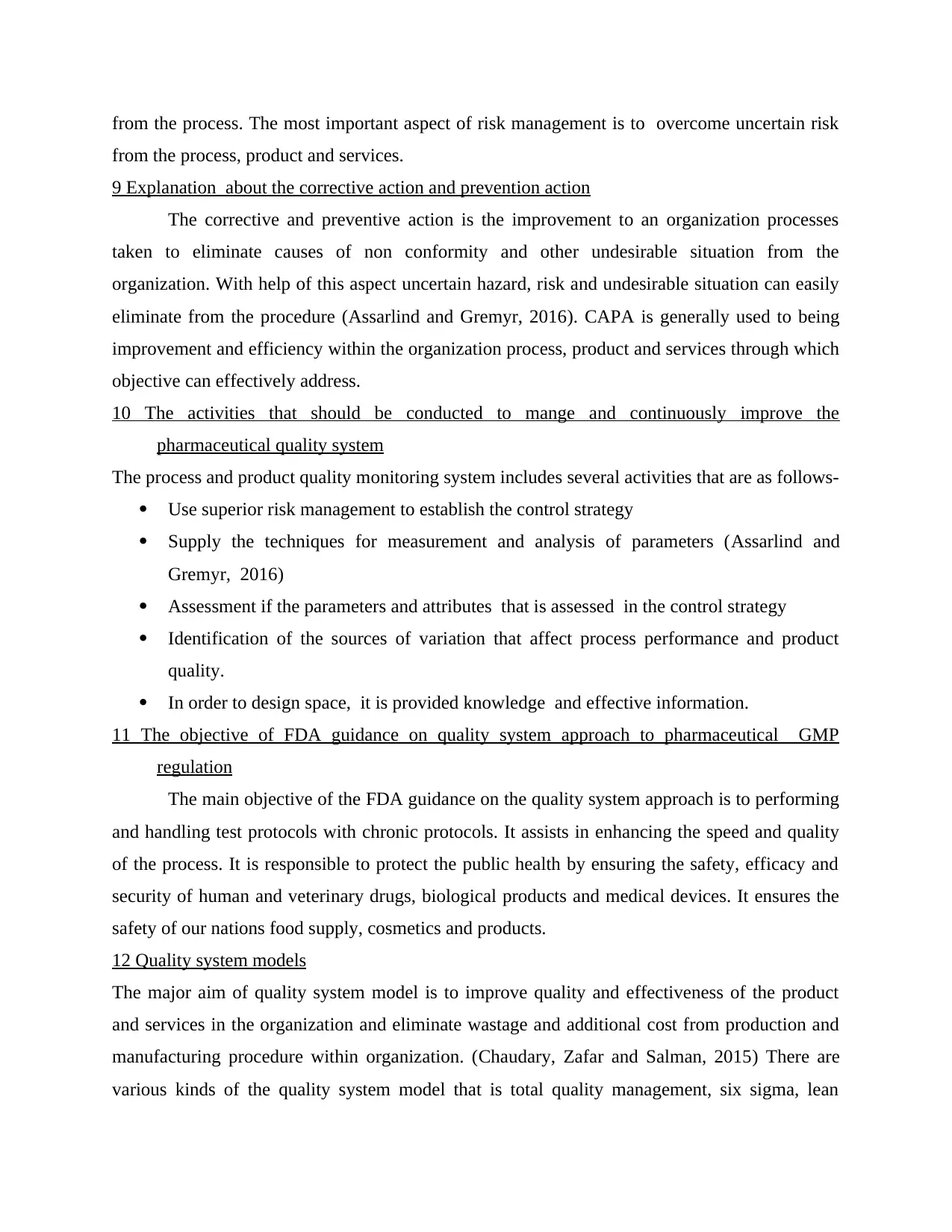
from the process. The most important aspect of risk management is to overcome uncertain risk
from the process, product and services.
9 Explanation about the corrective action and prevention action
The corrective and preventive action is the improvement to an organization processes
taken to eliminate causes of non conformity and other undesirable situation from the
organization. With help of this aspect uncertain hazard, risk and undesirable situation can easily
eliminate from the procedure (Assarlind and Gremyr, 2016). CAPA is generally used to being
improvement and efficiency within the organization process, product and services through which
objective can effectively address.
10 The activities that should be conducted to mange and continuously improve the
pharmaceutical quality system
The process and product quality monitoring system includes several activities that are as follows-
Use superior risk management to establish the control strategy
Supply the techniques for measurement and analysis of parameters (Assarlind and
Gremyr, 2016)
Assessment if the parameters and attributes that is assessed in the control strategy
Identification of the sources of variation that affect process performance and product
quality.
In order to design space, it is provided knowledge and effective information.
11 The objective of FDA guidance on quality system approach to pharmaceutical GMP
regulation
The main objective of the FDA guidance on the quality system approach is to performing
and handling test protocols with chronic protocols. It assists in enhancing the speed and quality
of the process. It is responsible to protect the public health by ensuring the safety, efficacy and
security of human and veterinary drugs, biological products and medical devices. It ensures the
safety of our nations food supply, cosmetics and products.
12 Quality system models
The major aim of quality system model is to improve quality and effectiveness of the product
and services in the organization and eliminate wastage and additional cost from production and
manufacturing procedure within organization. (Chaudary, Zafar and Salman, 2015) There are
various kinds of the quality system model that is total quality management, six sigma, lean
from the process, product and services.
9 Explanation about the corrective action and prevention action
The corrective and preventive action is the improvement to an organization processes
taken to eliminate causes of non conformity and other undesirable situation from the
organization. With help of this aspect uncertain hazard, risk and undesirable situation can easily
eliminate from the procedure (Assarlind and Gremyr, 2016). CAPA is generally used to being
improvement and efficiency within the organization process, product and services through which
objective can effectively address.
10 The activities that should be conducted to mange and continuously improve the
pharmaceutical quality system
The process and product quality monitoring system includes several activities that are as follows-
Use superior risk management to establish the control strategy
Supply the techniques for measurement and analysis of parameters (Assarlind and
Gremyr, 2016)
Assessment if the parameters and attributes that is assessed in the control strategy
Identification of the sources of variation that affect process performance and product
quality.
In order to design space, it is provided knowledge and effective information.
11 The objective of FDA guidance on quality system approach to pharmaceutical GMP
regulation
The main objective of the FDA guidance on the quality system approach is to performing
and handling test protocols with chronic protocols. It assists in enhancing the speed and quality
of the process. It is responsible to protect the public health by ensuring the safety, efficacy and
security of human and veterinary drugs, biological products and medical devices. It ensures the
safety of our nations food supply, cosmetics and products.
12 Quality system models
The major aim of quality system model is to improve quality and effectiveness of the product
and services in the organization and eliminate wastage and additional cost from production and
manufacturing procedure within organization. (Chaudary, Zafar and Salman, 2015) There are
various kinds of the quality system model that is total quality management, six sigma, lean
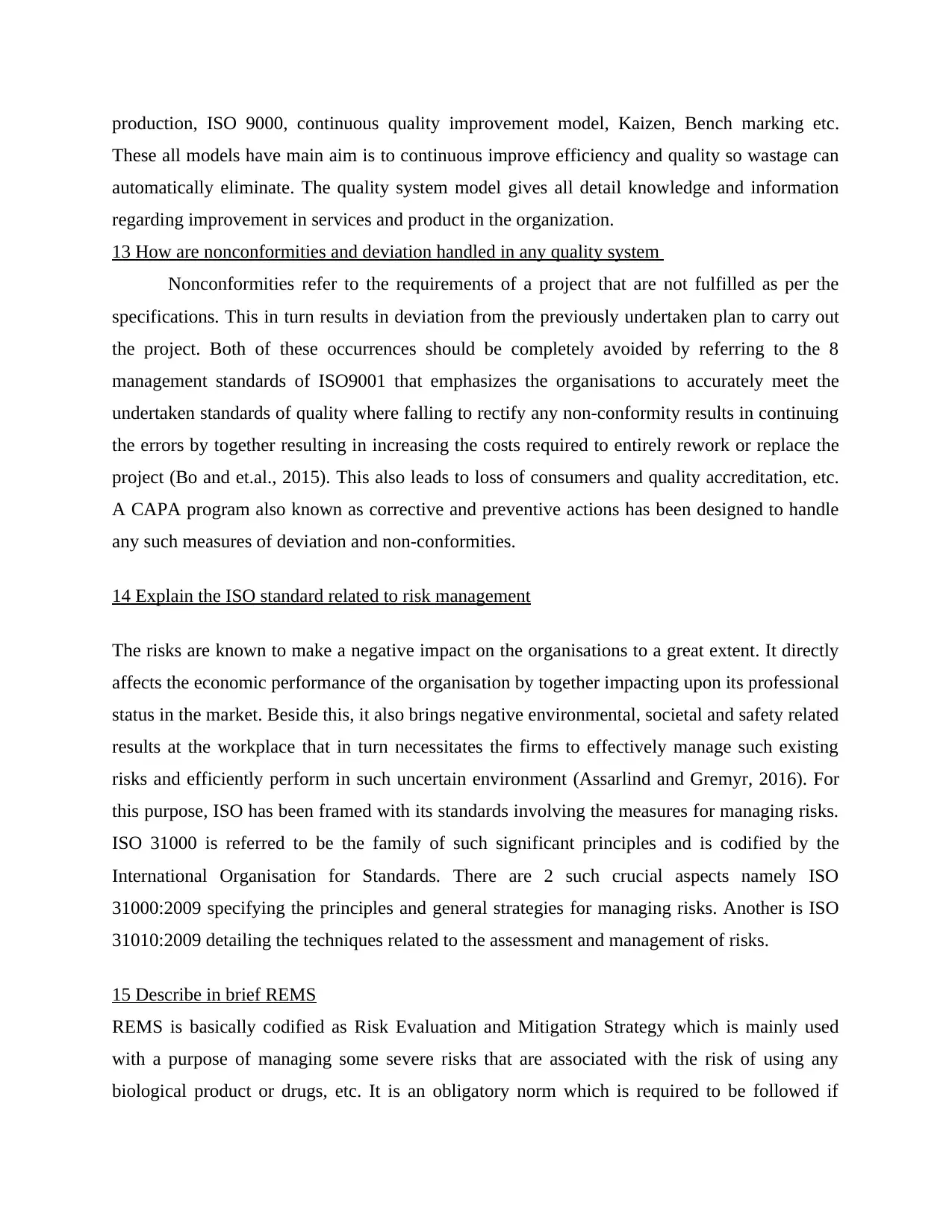
production, ISO 9000, continuous quality improvement model, Kaizen, Bench marking etc.
These all models have main aim is to continuous improve efficiency and quality so wastage can
automatically eliminate. The quality system model gives all detail knowledge and information
regarding improvement in services and product in the organization.
13 How are nonconformities and deviation handled in any quality system
Nonconformities refer to the requirements of a project that are not fulfilled as per the
specifications. This in turn results in deviation from the previously undertaken plan to carry out
the project. Both of these occurrences should be completely avoided by referring to the 8
management standards of ISO9001 that emphasizes the organisations to accurately meet the
undertaken standards of quality where falling to rectify any non-conformity results in continuing
the errors by together resulting in increasing the costs required to entirely rework or replace the
project (Bo and et.al., 2015). This also leads to loss of consumers and quality accreditation, etc.
A CAPA program also known as corrective and preventive actions has been designed to handle
any such measures of deviation and non-conformities.
14 Explain the ISO standard related to risk management
The risks are known to make a negative impact on the organisations to a great extent. It directly
affects the economic performance of the organisation by together impacting upon its professional
status in the market. Beside this, it also brings negative environmental, societal and safety related
results at the workplace that in turn necessitates the firms to effectively manage such existing
risks and efficiently perform in such uncertain environment (Assarlind and Gremyr, 2016). For
this purpose, ISO has been framed with its standards involving the measures for managing risks.
ISO 31000 is referred to be the family of such significant principles and is codified by the
International Organisation for Standards. There are 2 such crucial aspects namely ISO
31000:2009 specifying the principles and general strategies for managing risks. Another is ISO
31010:2009 detailing the techniques related to the assessment and management of risks.
15 Describe in brief REMS
REMS is basically codified as Risk Evaluation and Mitigation Strategy which is mainly used
with a purpose of managing some severe risks that are associated with the risk of using any
biological product or drugs, etc. It is an obligatory norm which is required to be followed if
These all models have main aim is to continuous improve efficiency and quality so wastage can
automatically eliminate. The quality system model gives all detail knowledge and information
regarding improvement in services and product in the organization.
13 How are nonconformities and deviation handled in any quality system
Nonconformities refer to the requirements of a project that are not fulfilled as per the
specifications. This in turn results in deviation from the previously undertaken plan to carry out
the project. Both of these occurrences should be completely avoided by referring to the 8
management standards of ISO9001 that emphasizes the organisations to accurately meet the
undertaken standards of quality where falling to rectify any non-conformity results in continuing
the errors by together resulting in increasing the costs required to entirely rework or replace the
project (Bo and et.al., 2015). This also leads to loss of consumers and quality accreditation, etc.
A CAPA program also known as corrective and preventive actions has been designed to handle
any such measures of deviation and non-conformities.
14 Explain the ISO standard related to risk management
The risks are known to make a negative impact on the organisations to a great extent. It directly
affects the economic performance of the organisation by together impacting upon its professional
status in the market. Beside this, it also brings negative environmental, societal and safety related
results at the workplace that in turn necessitates the firms to effectively manage such existing
risks and efficiently perform in such uncertain environment (Assarlind and Gremyr, 2016). For
this purpose, ISO has been framed with its standards involving the measures for managing risks.
ISO 31000 is referred to be the family of such significant principles and is codified by the
International Organisation for Standards. There are 2 such crucial aspects namely ISO
31000:2009 specifying the principles and general strategies for managing risks. Another is ISO
31010:2009 detailing the techniques related to the assessment and management of risks.
15 Describe in brief REMS
REMS is basically codified as Risk Evaluation and Mitigation Strategy which is mainly used
with a purpose of managing some severe risks that are associated with the risk of using any
biological product or drugs, etc. It is an obligatory norm which is required to be followed if
⊘ This is a preview!⊘
Do you want full access?
Subscribe today to unlock all pages.

Trusted by 1+ million students worldwide
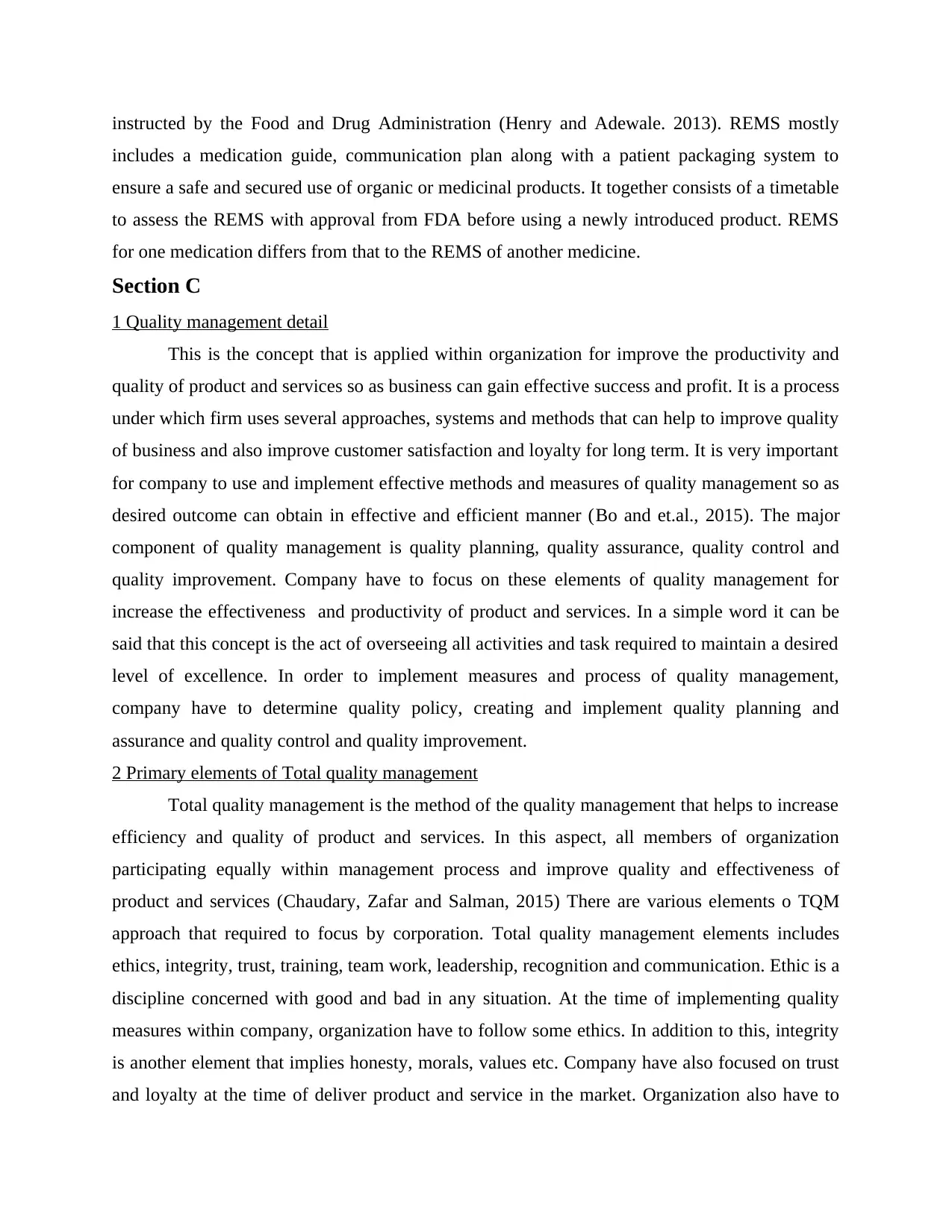
instructed by the Food and Drug Administration (Henry and Adewale. 2013). REMS mostly
includes a medication guide, communication plan along with a patient packaging system to
ensure a safe and secured use of organic or medicinal products. It together consists of a timetable
to assess the REMS with approval from FDA before using a newly introduced product. REMS
for one medication differs from that to the REMS of another medicine.
Section C
1 Quality management detail
This is the concept that is applied within organization for improve the productivity and
quality of product and services so as business can gain effective success and profit. It is a process
under which firm uses several approaches, systems and methods that can help to improve quality
of business and also improve customer satisfaction and loyalty for long term. It is very important
for company to use and implement effective methods and measures of quality management so as
desired outcome can obtain in effective and efficient manner (Bo and et.al., 2015). The major
component of quality management is quality planning, quality assurance, quality control and
quality improvement. Company have to focus on these elements of quality management for
increase the effectiveness and productivity of product and services. In a simple word it can be
said that this concept is the act of overseeing all activities and task required to maintain a desired
level of excellence. In order to implement measures and process of quality management,
company have to determine quality policy, creating and implement quality planning and
assurance and quality control and quality improvement.
2 Primary elements of Total quality management
Total quality management is the method of the quality management that helps to increase
efficiency and quality of product and services. In this aspect, all members of organization
participating equally within management process and improve quality and effectiveness of
product and services (Chaudary, Zafar and Salman, 2015) There are various elements o TQM
approach that required to focus by corporation. Total quality management elements includes
ethics, integrity, trust, training, team work, leadership, recognition and communication. Ethic is a
discipline concerned with good and bad in any situation. At the time of implementing quality
measures within company, organization have to follow some ethics. In addition to this, integrity
is another element that implies honesty, morals, values etc. Company have also focused on trust
and loyalty at the time of deliver product and service in the market. Organization also have to
includes a medication guide, communication plan along with a patient packaging system to
ensure a safe and secured use of organic or medicinal products. It together consists of a timetable
to assess the REMS with approval from FDA before using a newly introduced product. REMS
for one medication differs from that to the REMS of another medicine.
Section C
1 Quality management detail
This is the concept that is applied within organization for improve the productivity and
quality of product and services so as business can gain effective success and profit. It is a process
under which firm uses several approaches, systems and methods that can help to improve quality
of business and also improve customer satisfaction and loyalty for long term. It is very important
for company to use and implement effective methods and measures of quality management so as
desired outcome can obtain in effective and efficient manner (Bo and et.al., 2015). The major
component of quality management is quality planning, quality assurance, quality control and
quality improvement. Company have to focus on these elements of quality management for
increase the effectiveness and productivity of product and services. In a simple word it can be
said that this concept is the act of overseeing all activities and task required to maintain a desired
level of excellence. In order to implement measures and process of quality management,
company have to determine quality policy, creating and implement quality planning and
assurance and quality control and quality improvement.
2 Primary elements of Total quality management
Total quality management is the method of the quality management that helps to increase
efficiency and quality of product and services. In this aspect, all members of organization
participating equally within management process and improve quality and effectiveness of
product and services (Chaudary, Zafar and Salman, 2015) There are various elements o TQM
approach that required to focus by corporation. Total quality management elements includes
ethics, integrity, trust, training, team work, leadership, recognition and communication. Ethic is a
discipline concerned with good and bad in any situation. At the time of implementing quality
measures within company, organization have to follow some ethics. In addition to this, integrity
is another element that implies honesty, morals, values etc. Company have also focused on trust
and loyalty at the time of deliver product and service in the market. Organization also have to
Paraphrase This Document
Need a fresh take? Get an instant paraphrase of this document with our AI Paraphraser
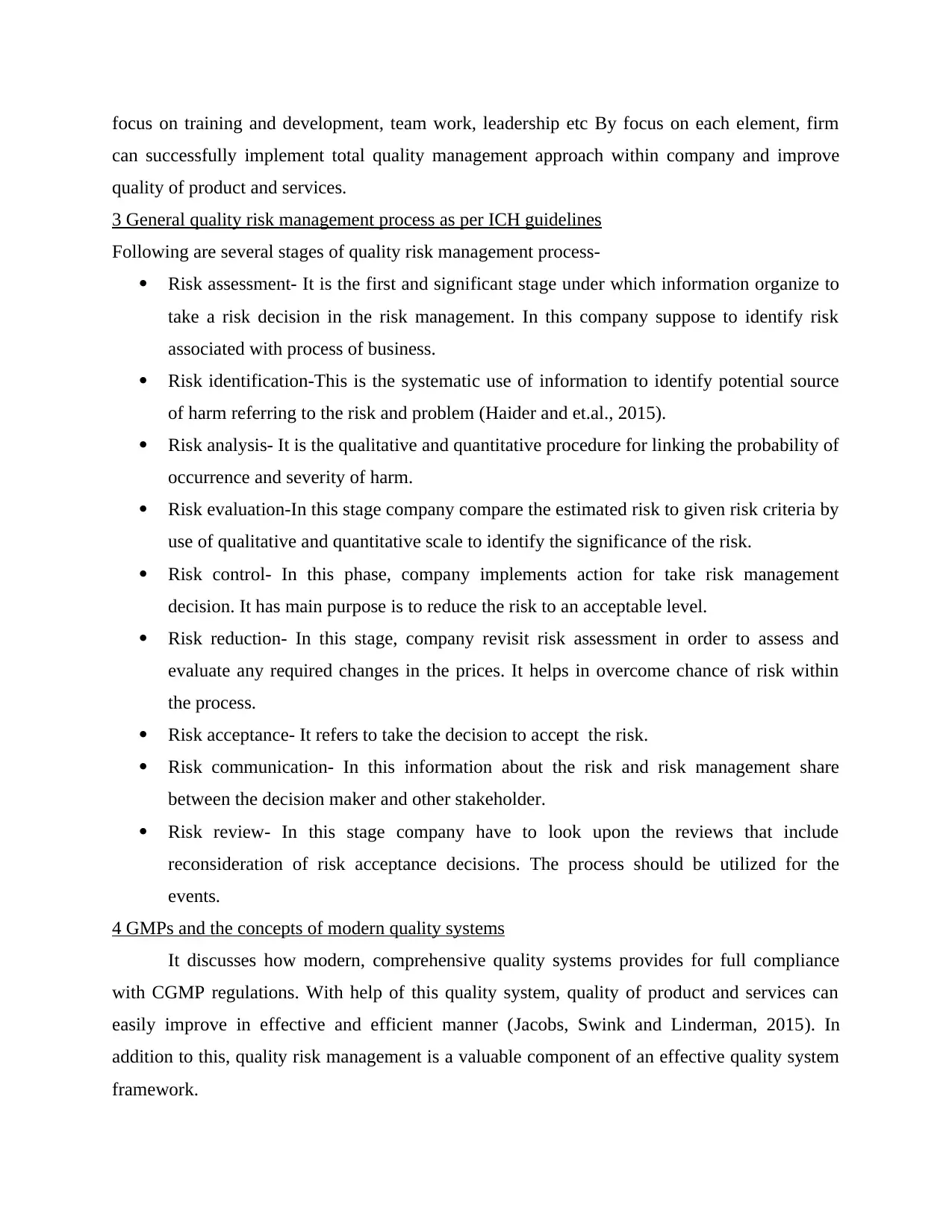
focus on training and development, team work, leadership etc By focus on each element, firm
can successfully implement total quality management approach within company and improve
quality of product and services.
3 General quality risk management process as per ICH guidelines
Following are several stages of quality risk management process-
Risk assessment- It is the first and significant stage under which information organize to
take a risk decision in the risk management. In this company suppose to identify risk
associated with process of business.
Risk identification-This is the systematic use of information to identify potential source
of harm referring to the risk and problem (Haider and et.al., 2015).
Risk analysis- It is the qualitative and quantitative procedure for linking the probability of
occurrence and severity of harm.
Risk evaluation-In this stage company compare the estimated risk to given risk criteria by
use of qualitative and quantitative scale to identify the significance of the risk.
Risk control- In this phase, company implements action for take risk management
decision. It has main purpose is to reduce the risk to an acceptable level.
Risk reduction- In this stage, company revisit risk assessment in order to assess and
evaluate any required changes in the prices. It helps in overcome chance of risk within
the process.
Risk acceptance- It refers to take the decision to accept the risk.
Risk communication- In this information about the risk and risk management share
between the decision maker and other stakeholder.
Risk review- In this stage company have to look upon the reviews that include
reconsideration of risk acceptance decisions. The process should be utilized for the
events.
4 GMPs and the concepts of modern quality systems
It discusses how modern, comprehensive quality systems provides for full compliance
with CGMP regulations. With help of this quality system, quality of product and services can
easily improve in effective and efficient manner (Jacobs, Swink and Linderman, 2015). In
addition to this, quality risk management is a valuable component of an effective quality system
framework.
can successfully implement total quality management approach within company and improve
quality of product and services.
3 General quality risk management process as per ICH guidelines
Following are several stages of quality risk management process-
Risk assessment- It is the first and significant stage under which information organize to
take a risk decision in the risk management. In this company suppose to identify risk
associated with process of business.
Risk identification-This is the systematic use of information to identify potential source
of harm referring to the risk and problem (Haider and et.al., 2015).
Risk analysis- It is the qualitative and quantitative procedure for linking the probability of
occurrence and severity of harm.
Risk evaluation-In this stage company compare the estimated risk to given risk criteria by
use of qualitative and quantitative scale to identify the significance of the risk.
Risk control- In this phase, company implements action for take risk management
decision. It has main purpose is to reduce the risk to an acceptable level.
Risk reduction- In this stage, company revisit risk assessment in order to assess and
evaluate any required changes in the prices. It helps in overcome chance of risk within
the process.
Risk acceptance- It refers to take the decision to accept the risk.
Risk communication- In this information about the risk and risk management share
between the decision maker and other stakeholder.
Risk review- In this stage company have to look upon the reviews that include
reconsideration of risk acceptance decisions. The process should be utilized for the
events.
4 GMPs and the concepts of modern quality systems
It discusses how modern, comprehensive quality systems provides for full compliance
with CGMP regulations. With help of this quality system, quality of product and services can
easily improve in effective and efficient manner (Jacobs, Swink and Linderman, 2015). In
addition to this, quality risk management is a valuable component of an effective quality system
framework.
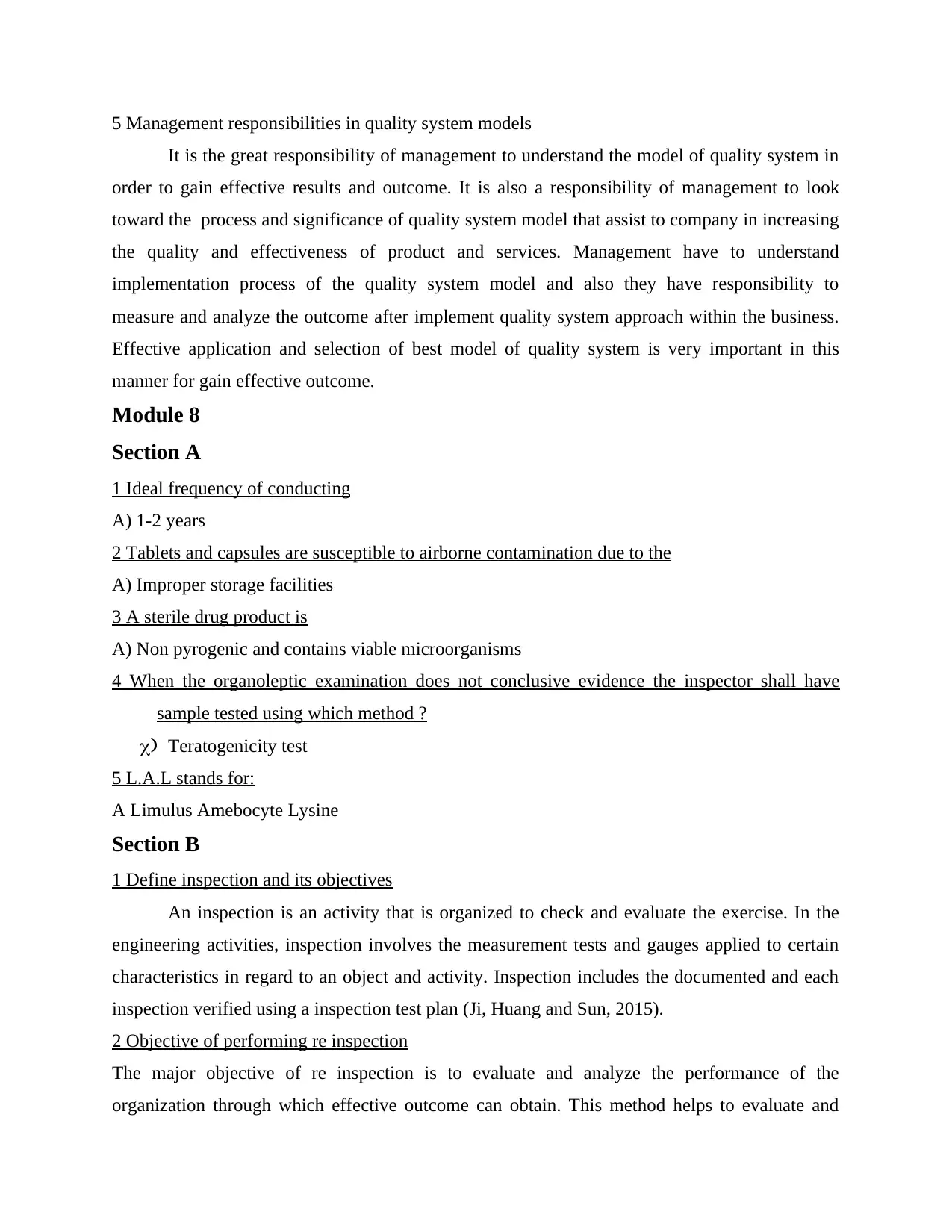
5 Management responsibilities in quality system models
It is the great responsibility of management to understand the model of quality system in
order to gain effective results and outcome. It is also a responsibility of management to look
toward the process and significance of quality system model that assist to company in increasing
the quality and effectiveness of product and services. Management have to understand
implementation process of the quality system model and also they have responsibility to
measure and analyze the outcome after implement quality system approach within the business.
Effective application and selection of best model of quality system is very important in this
manner for gain effective outcome.
Module 8
Section A
1 Ideal frequency of conducting
A) 1-2 years
2 Tablets and capsules are susceptible to airborne contamination due to the
A) Improper storage facilities
3 A sterile drug product is
A) Non pyrogenic and contains viable microorganisms
4 When the organoleptic examination does not conclusive evidence the inspector shall have
sample tested using which method ?
c) Teratogenicity test
5 L.A.L stands for:
A Limulus Amebocyte Lysine
Section B
1 Define inspection and its objectives
An inspection is an activity that is organized to check and evaluate the exercise. In the
engineering activities, inspection involves the measurement tests and gauges applied to certain
characteristics in regard to an object and activity. Inspection includes the documented and each
inspection verified using a inspection test plan (Ji, Huang and Sun, 2015).
2 Objective of performing re inspection
The major objective of re inspection is to evaluate and analyze the performance of the
organization through which effective outcome can obtain. This method helps to evaluate and
It is the great responsibility of management to understand the model of quality system in
order to gain effective results and outcome. It is also a responsibility of management to look
toward the process and significance of quality system model that assist to company in increasing
the quality and effectiveness of product and services. Management have to understand
implementation process of the quality system model and also they have responsibility to
measure and analyze the outcome after implement quality system approach within the business.
Effective application and selection of best model of quality system is very important in this
manner for gain effective outcome.
Module 8
Section A
1 Ideal frequency of conducting
A) 1-2 years
2 Tablets and capsules are susceptible to airborne contamination due to the
A) Improper storage facilities
3 A sterile drug product is
A) Non pyrogenic and contains viable microorganisms
4 When the organoleptic examination does not conclusive evidence the inspector shall have
sample tested using which method ?
c) Teratogenicity test
5 L.A.L stands for:
A Limulus Amebocyte Lysine
Section B
1 Define inspection and its objectives
An inspection is an activity that is organized to check and evaluate the exercise. In the
engineering activities, inspection involves the measurement tests and gauges applied to certain
characteristics in regard to an object and activity. Inspection includes the documented and each
inspection verified using a inspection test plan (Ji, Huang and Sun, 2015).
2 Objective of performing re inspection
The major objective of re inspection is to evaluate and analyze the performance of the
organization through which effective outcome can obtain. This method helps to evaluate and
⊘ This is a preview!⊘
Do you want full access?
Subscribe today to unlock all pages.

Trusted by 1+ million students worldwide
1 out of 31
Related Documents
Your All-in-One AI-Powered Toolkit for Academic Success.
+13062052269
info@desklib.com
Available 24*7 on WhatsApp / Email
![[object Object]](/_next/static/media/star-bottom.7253800d.svg)
Unlock your academic potential
Copyright © 2020–2025 A2Z Services. All Rights Reserved. Developed and managed by ZUCOL.





